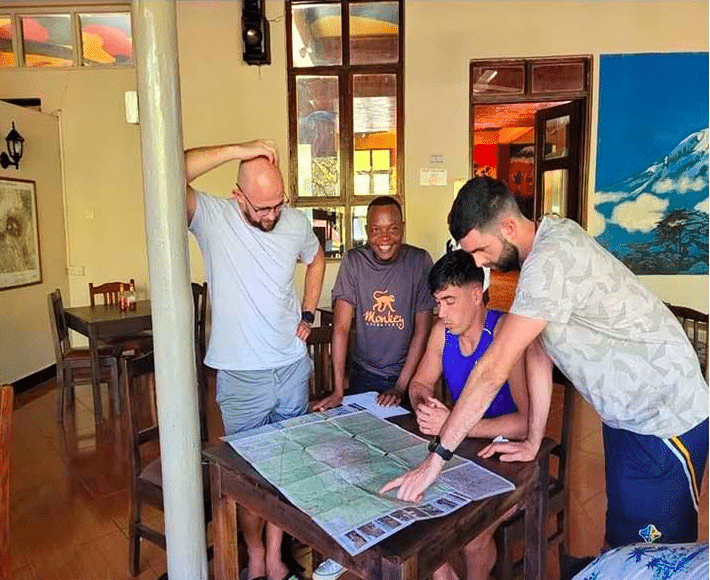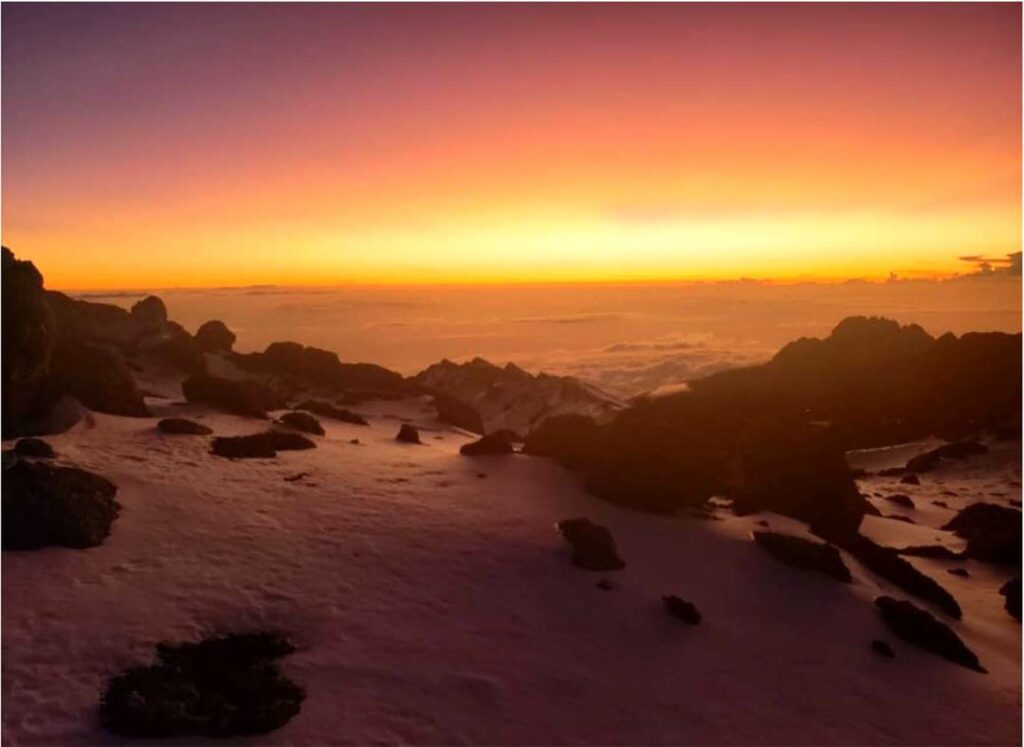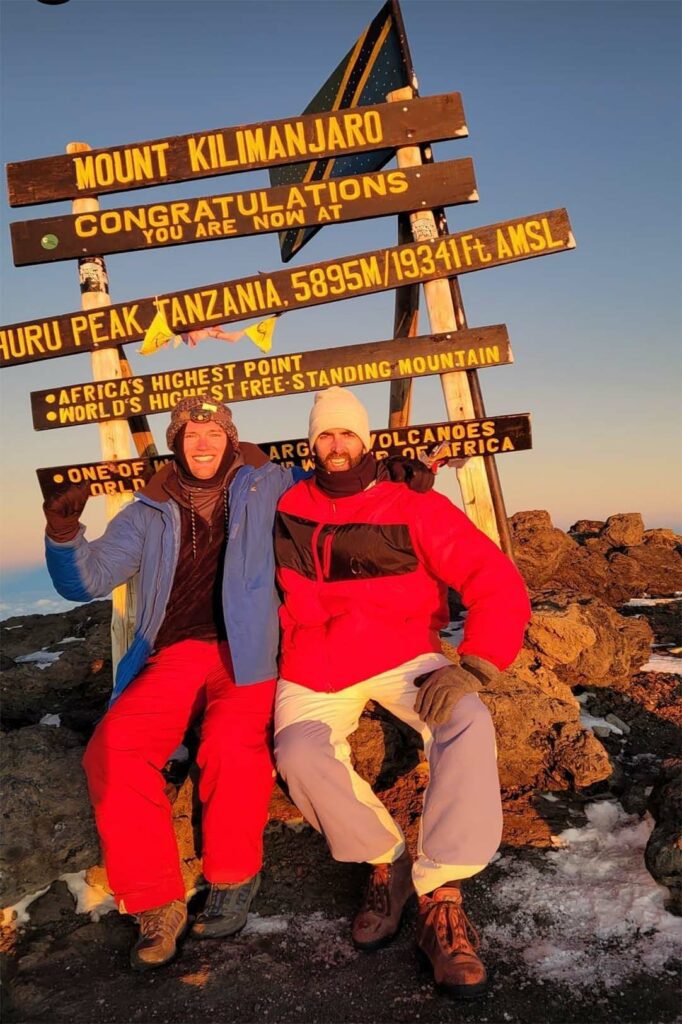by Michael Cannon
The planes became smaller as we ticked off the various stopovers en route to our destination. A late-night flight from Dubai to Nairobi and then a short flight onto the tiny and beautiful Kilimanjaro airport in Northern Tanzania. The final approach brought with it amazing views of the challenge that lay ahead. From our bird’s eye seat in the clouds, we remarked confidently “Doesn´t look too bad”.
After filling out a little paperwork at the airport, we were met by our Expedition guide Rama and a driver. Our bags were loaded onto the small minibus and off we went through the African countryside towards the city of Moshi where we would stay the night. This part of Africa really is an amazing place and unlike anywhere I’ve been before. There are literally people everywhere, yet the impact on the surrounding natural environment is minimal.

On arrival at our hotel, we were given a briefing on our upcoming challenge. A map highlighting the proposed 5-day Lemosho route was laid before us…. destination Uhuru Peak aka The summit of Kilimanjaro.
The following morning, after breakfast and a final gear check, we headed off on an old school bus along with a crew of 15 porters, cooks and guides towards Lemosho gate where we would begin our climb. A relatively short 3-hour hike through dense mountain jungle was made memorable by the torrential rain that welcomed us. We arrived at Mkubwa Camp (2400m) around 4 pm. Our camp had already been set up in advance of our arrival by the impressive speed of our local porters, who power ahead of us on the trail each morning. 2 small tents for the 4 of us to sleep in, a mess tent for serving meals and a larger tent which acts as a makeshift kitchen, lounge and sleeping quarters for all 15 of our porters. After a brisk shower (small bucket with lukewarm water) and dinner, we settled in for the night.
The morning routine on Kilimanjaro consists of a wake-up call around 7 am with another lukewarm bucket of water and some coffee. The porters take down the camp as quickly as they assemble it and off they go again! Today we have a 17km trek to Shira II camp. We leave the bustle of the jungle behind as we ascend into a barren Moorland landscape. The first 3 hours of our day are filled with glorious sunshine, but as the day rolls on and the temperatures rise, clouds roll in and an eerie quiet descends on the trail. We pass the time mostly with sports questions, quizzes and stories. Sometimes we listen to music or podcasts that we´ve saved in advance. We ask Rama and Chris, our guides, about their lives here on Kili and below in Moshi. The pace is relaxed, and breaks are taken as needed. “Pole Pole”, say the guides on countless occasions throughout the day, which means “slowly slowly” in Swahili, one of the many local languages. On Kilimanjaro as with other big mountains, slow and steady wins the race!
We arrive at camp in the early evening and set about our routine. A quick wash and change of clothes were followed by card games as we waited for dinner. Aaron has managed to squeeze his iPad into his rucksack, so we also have several episodes of “House of Cards” to help pass the long evenings. We usually head for our sleeping bags around 9 pm as the temperature drops and darkness descends. I´m “tenting” with Aaron, who zips down his sleeping bag and slips out into the darkness to answer nature’s call with impressive punctuality on every single night of our climb. The mornings on Kilimanjaro are the most breathtaking. The clouds have descended overnight onto the surrounding plains and so each morning we emerge from our tents and enjoy breakfast looking out over the sea of white below.

Today, we are heading on an 8-hour acclimatisation trek to Baranco Camp (3900m) via Lava Tower (4600m). Climb High, Sleep Low is the policy of success each day on such expeditions. The idea is to gradually expose the body to higher and higher altitudes, forcing it to adjust, before descending again to sleep and recuperate at an altitude the body is already used to. This is the toughest day so far. The route is steep and the air is notably thinner. Small tasks take greater effort.
Phil and Aaron are feeling the effects of migraine and the wholesome meal our cook has prepared doesn’t seem appealing. We do our best to force it down! The next day is a more technical but enjoyable climb. We traverse the “breakfast wall”, a steep and jagged rock wall, before a long day of gaining and giving back ascended metres on the way to Karanga. Choosing your climbing partners wisely is an essential part of planning such trips. On days when the going is tough, it helps to have easy and familiar company. On days like today, I knew I had chosen well with Aaron, Phil and Dermot, all living and working in Abu Dhabi.
From Karanga, we trek a further 4 hours to reach the high camp (4673m) for our Summit push. We meet many other climbers here who have ascended via the various routes to meet at this point in the hope of achieving their goal. We can see the summit from here through gaps in the cloud. It looks close-ish. We wash up for dinner before checking our gear for the summit climb. We plan on leaving at midnight to reach the Summit of Africa for sunrise around 6:30 am. Although our sleep is broken and short, we emerge from our tents with nervous anticipation to the sights and sounds of climbers gearing up in the dark. With our heaviest down-jackets and summit trousers on, we begin to ascend the steep zig-zag trail up the mountain. Our head torches and those of our guides light the way.
Darkness and silence surround us, the only sound coming from the crackle of our boots on the snow underneath. We meander along the path in a single file. When our guides sense that morale is low, they break out into a song. Bob Marley or else something in Swahili. I think it helps! Some of the lads disagree. It´s a surreal feeling of being so far removed from reality and so far from home. It´s a tough slog mentally and we are all now feeling the dizzying effects of the altitude. We plod on with the optimism that the sun will eventually dawn and lift our spirits. As we approach the 6-hour mark, we begin to make out the silhouette of a horizon up ahead. It’s Stella Point (5756m), one of the three official summits of Kili. From here, it’s a comparatively easy 40-minute trek across to Uhuru Peak (5895m), the summit of Kilimanjaro and the highest free-standing mountain in the world.

The sun rises as we step onto the top and look across at the small wooden cross-like structure in the distance which marks the summit. It´s the most spectacular view I’ve ever seen. We spend around 20 minutes on the summit before turning to face the reality of the long trek home. The plan was to descend to base camp, rest and eat, before heading for another camp some 15km away, to overnight and then finish our descent the following day. However, the lure of a warm hotel bed, shower and food was enough to power us through the entire 30km descent in one gruelling effort. That night in our hotel, we relax and reflect on the experience and the memories made with a cold bottle of beer. It´s an extremely satisfying and rewarding feeling and one that can be accomplished by anyone who plans and prepares accordingly. Pole, Pole!




